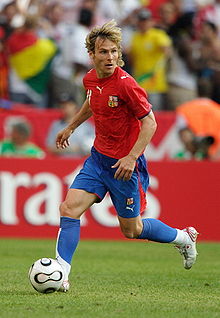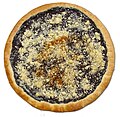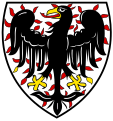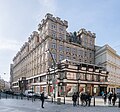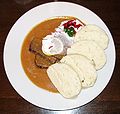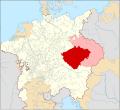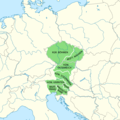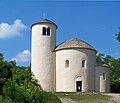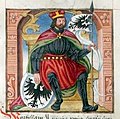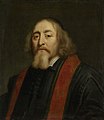Portal:Czech Republic
Welcome to the Czech Portal!
Vítejte na Českém portálu!

|

|
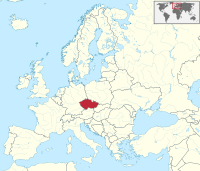
| |
The Czech Republic, also known as Czechia, is a landlocked country in Central and Eastern Europe. Historically known as Bohemia, it is bordered by Austria to the south, Germany to the west, Poland to the northeast, and Slovakia to the southeast. The Czech Republic has a hilly landscape that covers an area of 78,871 square kilometers (30,452 sq mi) with a mostly temperate continental and oceanic climate. The capital and largest city is Prague; other major cities and urban areas include Brno, Ostrava, Plzeň and Liberec.
The Duchy of Bohemia was founded in the late 9th century under Great Moravia. It was formally recognized as an Imperial State of the Holy Roman Empire in 1002 and became a kingdom in 1198. Following the Battle of Mohács in 1526, all of the Crown lands of Bohemia were gradually integrated into the Habsburg monarchy. Nearly a hundred years later, the Protestant Bohemian Revolt led to the Thirty Years' War. After the Battle of White Mountain, the Habsburgs consolidated their rule. With the dissolution of the Holy Roman Empire in 1806, the Crown lands became part of the Austrian Empire.
In the 19th century, the Czech lands became more industrialized, and in 1918 most of it became part of the First Czechoslovak Republic following the collapse of Austria-Hungary after World War I. Czechoslovakia was the only country in Central and Eastern Europe to remain a parliamentary democracy during the entirety of the interwar period. After the Munich Agreement in 1938, Nazi Germany systematically took control over the Czech lands.
Czechoslovakia was restored in 1945 and three years later became an Eastern Bloc communist state following a coup d'état in 1948. Attempts to liberalize the government and economy were suppressed by a Soviet-led invasion of the country during the Prague Spring in 1968. In November 1989, the Velvet Revolution ended communist rule in the country and restored democracy. On 31 December 1992, Czechoslovakia was peacefully dissolved, with its constituent states becoming the independent states of the Czech Republic and Slovakia.
The Czech Republic is a unitary parliamentary republic and developed country with an advanced, high-income social market economy. It is a welfare state with a European social model, universal health care and free-tuition university education. It ranks 32nd in the Human Development Index. The Czech Republic is a member of the United Nations, NATO, the European Union, the OECD, the OSCE, the Council of Europe and the Visegrád Group. (Full article...)
Selected article -
The Giant Mountains, Krkonoše, or Karkonosze (Czech: [ˈkr̩konoʃɛ] ⓘ, Polish pronunciation: [karkɔˈnɔʂɛ] ⓘ, German: Riesengebirge pronounced [ˈʁiːzn̩ɡəˌbɪʁɡə] ⓘ), are a mountain range located in the north of the Czech Republic and the south-west of Poland, part of the Sudetes mountain system (part of the Bohemian Massif). The Czech-Polish border, which divides the historic regions of Bohemia and Silesia, runs along the main ridge. The highest peak, Sněžka (Polish: Śnieżka), is the Czech Republic's highest natural point with an elevation of 1,603 metres (5,259 ft).
On both sides of the border, large areas of the mountains are designated national parks (Krkonoše National Park in the Czech Republic and Karkonosze National Park in Poland), and these together comprise the Krkonoše/Karkonosze Transboundary Biosphere Reserve under the UNESCO Man and the Biosphere Programme. The source of the River Elbe is within the Giant Mountains. The range has a number of major ski resorts, and is a popular destination for tourists engaging in downhill and cross-country skiing, hiking, cycling and other activities. (Full article...)Selected picture

Source: Národní Galerie v Praze, PD
In this month
- 1 May 2004 – The Czech Republic joins the European Union
- 9 May 1974 – The Prague Metro begins operation
- 14 May 1855 – The book The Grandmother by Božena Němcová is released
- 27 May 1942 – An assassination attempt (pictured) on acting Reichsprotektor Reinhardt Heydrich in Prague as part of Operation Anthropoid results in him dying on 4 June – the villages of Lidice and Ležáky are razed to the ground in response
- 29 May 1975 – Gustáv Husák becomes President of Czechoslovakia, remaining in office until 1989
Categories
Selected biography -
Pavel Nedvěd (Czech pronunciation: [ˈpavɛl ˈnɛdvjɛt] ⓘ; born 30 August 1972) is a Czech former professional footballer who played as a midfielder. He is widely considered as one of the greatest midfielders of his generation and as one of the most successful players to emerge from the Czech Republic, winning domestic and European accolades with Italian clubs Lazio, including the last Cup Winners' Cup, and Juventus, whom he led to the 2003 UEFA Champions League final.
Nedvěd was a key member of the Czech team which reached the final of Euro 1996, during which he attracted international attention. He also captained the national team at UEFA Euro 2004, where they were defeated in the semi-final by eventual champions Greece, and Nedvěd was named as part of the Team of the Tournament. Furthermore, Nedvěd helped his team qualify for the 2006 FIFA World Cup for the first time since the breakup of Czechoslovakia. Due to his performances, as well as his quick and energetic runs during matches, Nedvěd was nicknamed "Furia Ceca" ("Czech Fury") by Italian fans and "The Czech cannon" in English-language media. His nickname in Czech is Méďa ("Little Bear"), stemming from the similarity between his surname and the Czech word for bear, Medvěd. (Full article...)Did you know?

- ...that in 1990, Czech and Slovak politicians "fought" the Hyphen War, a political battle over whether "Czechoslovakia" should be spelled with a hyphen?
- ... that the Cross of Merit of the Minister of Defence of the Czech Republic is the highest award presented by the Czech Minister of Defence?
- ... that Czech international footballer Patrik Gedeon went to play club football in Liechtenstein in the middle of his career?
- ... that a 1926 voyage to Java inspired Czech poet Konstantin Biebl for the remainder of his life?
General images
Related portals
Topics

Czech lands: Bohemia • Moravia • Czech Silesia
History: Únětice culture • Boii • Marcomanni • Samo • Great Moravia • Přemyslid dynasty • Lands of the Bohemian Crown • Czech lands (1526–1648) • 1648–1867 • 1867–1918) • Czechoslovakia • Czech Republic
Geography: Lakes • Protected areas • Regions • Rivers
Law: Judiciary • Law enforcement • Supreme Court of the Czech Republic
Politics: Administrative divisions • Government • Constitution • Elections • Foreign relations • Army • Parliament • Political parties • President • Prime Minister
Economy: Banks • Czech koruna • Energy • Oil and gas deposits • Stock Exchange • Tourism • Transport
Culture: Architecture • Art • Cinema • Cuisine • Demographics • Education • Language • Literature • Media • Music • Philosophy • Prostitution • Public holidays • Religion • Sport • Television • Video games
Symbols: Flag • Coat of arms • National anthem (Kde domov můj)
Lists: Outline of the Czech Republic • List of Czech Republic–related topics
WikiProjects
Featured and good content
Things to do
Wikimedia
The following Wikimedia Foundation sister projects provide more on this subject:
-
Commons
Free media repository -
Wikibooks
Free textbooks and manuals -
Wikidata
Free knowledge base -
Wikinews
Free-content news -
Wikiquote
Collection of quotations -
Wikisource
Free-content library -
Wikiversity
Free learning tools -
Wikivoyage
Free travel guide -
Wiktionary
Dictionary and thesaurus





